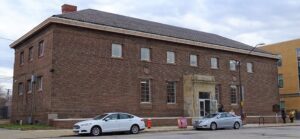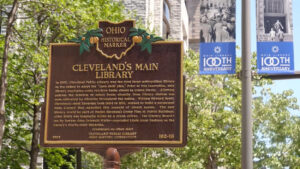, OH
City architect Frederic H. Betz designed the St. Clair Avenue Public Bath House and it was constructed in 1919-1920 at a cost of $320,000. The facility included a large gymnasium, swimming pool, and laundry, in addition to showers. City Council dedicated the newly completed building to the late, beloved Cleveland Indians shortstop Raymond Chapman in 1920. The St. Clair Recreation Center, as it was later known, was in the impact zone and survived the East Ohio Gas Company disaster on October 20, 1944. The facility was remodeled in 1949 and subsequent renovations demonstrate the utility of the building. Edward J. Kovacic (1910-1974) was the superintendent of the bathhouse from 1933-1934 and served on the City Council from 1940-1953. In 1977, the facility was renamed to honor Kovacic’s contributions to the citizens of the St. Clair neighborhood and to the city. (Continued on other side)
, OH
In 1890, Cleveland Public Library was the first large metropolitan library in the nation to adopt the “open shelf plan.” Prior to this innovation, only library employees could retrieve books stored in closed stacks. Allowing patrons the freedom to select books directly from library shelves was soon embraced by libraries throughout the nation. William Howard Brett, Cleveland’s chief librarian from 1884 to 1918, worked to build a permanent Main Library that embodied this concept of direct access. The new library would be part of Daniel Burnham’s Group Plan of Public Buildings. After Brett was tragically killed by a drunk driver, the Library Board — led by lawyer John Griswold White — appointed Linda Anne Eastman as the library’s fourth chief librarian. (Continued on other side)



